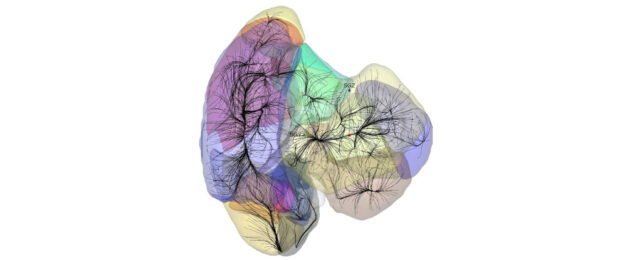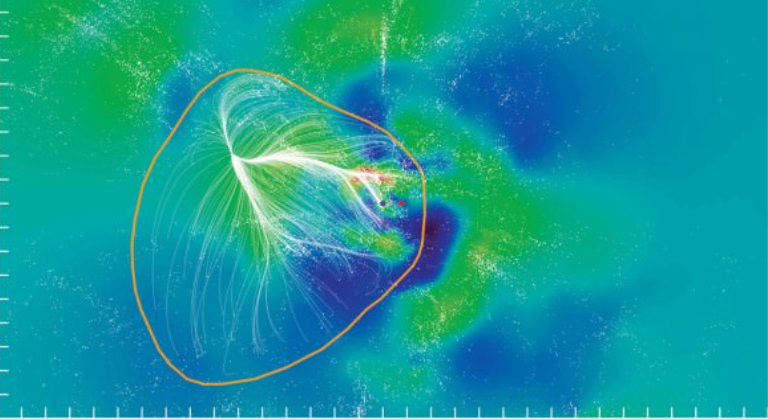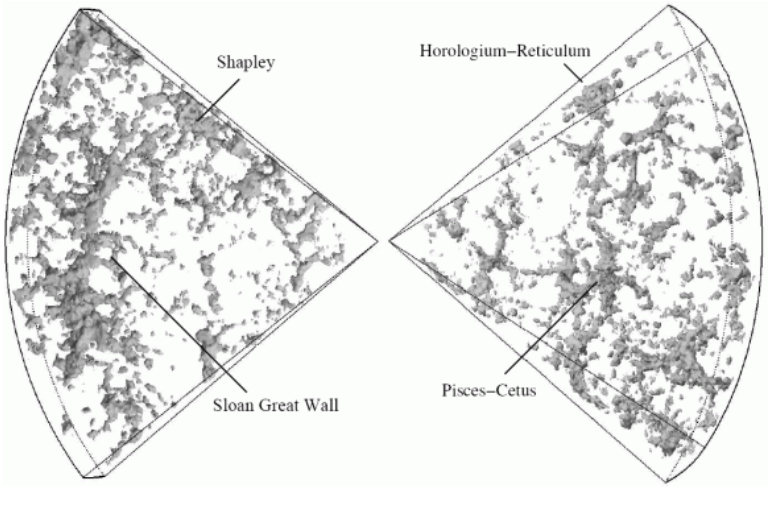ARTICLE AD
 A data visualization of the motions of galaxies in structures called basins of attraction. The Milky Way is the red dot. (University of Hawai'i)
A data visualization of the motions of galaxies in structures called basins of attraction. The Milky Way is the red dot. (University of Hawai'i)
If you want to pinpoint your place in the Universe, start with your cosmic address. You live on Earth->Solar System->Milky Way Galaxy->Local Cluster->Virgo Cluster->Virgo Supercluster->Laniakea.
Thanks to new deep sky surveys, astronomers now think all those places are part of an even bigger cosmic structure in the 'neighborhood' called the Shapley Concentration.
Astronomers refer to the Shapley Concentration as a "basin of attraction". That's a region loaded with mass that acts as an attractor. It's a region containing many clusters and groups of galaxies and comprises the greatest concentration of matter in the local Universe. All those galaxies, plus dark matter, lend their gravitational influence to the Concentration.
There are many of these basins in the Universe, including Laniakea. Astronomers are working to survey them more precisely, which should help provide a more precise map of the largest structures in the Universe.
 A slice of the Laniakea Supercluster, a local basin of attraction. This structure contains many galaxies and clusters, including our own Milky Way Galaxy. (SDvision interactive visualization software by DP at CEA/Saclay, France)
A slice of the Laniakea Supercluster, a local basin of attraction. This structure contains many galaxies and clusters, including our own Milky Way Galaxy. (SDvision interactive visualization software by DP at CEA/Saclay, France)One group, led by astronomer R. Brent Tully of the University of Hawai'i measured the motions of some 56,000 galaxies to understand these basins and their distribution in space.
"Our Universe is like a giant web, with galaxies lying along filaments and clustering at nodes where gravitational forces pull them together," said Tully.
"Just as water flows within watersheds, galaxies flow within cosmic basins of attraction. The discovery of these larger basins could fundamentally change our understanding of cosmic structure."
Cosmic flows and mapping structures
Tully's team is called CosmicFlows and they study the motions through space of those distant galaxies. The team's redshift surveys revealed a possible shift in the size and scale of our local galactic basin of attraction.
We already know that we live in Laniakea, which is about 500 million light-years across. However, the motions of other clusters indicate there's a larger attractor directing the cluster flow.
The CosmicFlows data suggest that we could be part of the Shapley Concentration, which could be 10 times the volume of Laniakea. It's about half the volume of the largest structure in space, known as The Great Wall, which is a string of galaxies stretching across 1.4 billion light-years.
 Several superclusters were revealed by the 2dF Galaxy Redshift Survey. This contains the structure known as the Sloan Great Wall. (Courtesy 2dF Galaxy Redshift Survey)
Several superclusters were revealed by the 2dF Galaxy Redshift Survey. This contains the structure known as the Sloan Great Wall. (Courtesy 2dF Galaxy Redshift Survey)The Shapley Concentration was first observed by astronomer Harlow Shapley in the 1930s as a cloud in the constellation Centaurus. This supercluster appears along the direction of motion of the Local Group of galaxies (where we live). Because of that, scientists speculated that it could be influencing our galaxy's peculiar motion.
Interestingly, the Virgo Supercluster (and the Local Group and Milky Way Galaxy) appears to be moving toward the Shapley Concentration. The surveys that Tully and others are doing should confirm that motion toward whatever is attracting them.
Exploring ever-larger structures in the Universe
Where do these basins of attraction come from? In one sense, they're as old as the Universe and its cosmic web of matter that Tully references. The seeds for the web and those basins of attraction were planted some 13.8 billion years ago.
After the Big Bang, the infant Universe was in a hot dense state. As it expanded and cooled, the density of matter started to fluctuate. There were tiny differences in those density fluctuations. Think of them as the earliest 'seeds' of galaxies, galaxy clusters, and even vaster structures that we see in today's Universe.
As astronomers survey the sky, they find evidence for all those different structures. Now, they have to explain them. The idea that the Shapley Concentration is the large basin that our Laniakea belongs to means that current cosmological models don't quite explain its existence.
"This discovery presents a challenge: our cosmic surveys may not yet be large enough to map the full extent of these immense basins," said UH astronomer Ehsan Kourkchi.
"We are still gazing through giant eyes, but even these eyes may not be big enough to capture the full picture of our Universe."
Measuring the attractors
The main actor in all these galaxies, clusters, and superclusters, is gravity. The more mass, the more gravity influences motions and matter distribution.
For these basins of attraction, Tully's research team examined their impact on galaxy motions in the region. The basins exert a sort of tug of war on galaxies that lie between them. That influences their motions. In particular, redshift surveys like Tully's team is doing will map the radial motion (along the line of sight), velocities (how fast they're moving), and other related motions.
By mapping the velocities of galaxies throughout our local Universe, the team can define the region of space where each supercluster dominates.
Of course, these motions are tricky to define. That's why the team does different types of measurements. They aren't mapping just the luminous material in galaxies. They also have to take into account the inferred existence of dark matter.
There are other complications as well. For example, not all galaxies are the same – that is, they differ in their shapes (morphology) and matter density. Astronomers can get around this by measuring something called "galaxy peculiar velocity". That's the difference between its actual velocity and the expected Hubble flow velocity (which reflects gravitational interactions between galaxies).
The results of the Tully team surveys should provide ever more precise 3D maps of these regions of space. That includes their structures as well as their motions and velocities. Those maps, in turn, should give greater insight into the distribution of all matter (including cold dark matter) throughout the Universe.
This article was originally published by Universe Today. Read the original article.

 1 month ago
13
1 month ago
13 

